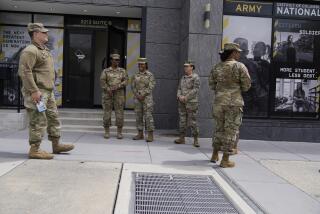America’s army of jobless
- Share via
When President Obama announced that 40,000 troops now in Iraq would come home by the end of the year, the initial excitement quickly turned to concern that our already struggling economy couldn’t easily handle the shock of an additional 40,000 job seekers.
Although we should, of course, care deeply about returning Iraq war veterans, we ought not to think for a moment that adding 40,000 workers to the job-seeking pool will break the back of the economy. It’s already broken. The nation is laboring under the weight of a reserve army of nearly 27 million women and men who don’t have a full-time job, but most surely want one.
The term “reserve army of labor” is vintage Karl Marx. But let’s not hold that against it if it’s on the mark. These workers are on reserve; they are standing ready to work. And their sheer numbers make them an army.
Who is in this reserve army? It has four quite distinct divisions. The first and best-known division, the unemployed, now includes about 13.9 million people, according to figures released in early November. About two-fifths of this group count as long-term unemployed (those jobless for 27 weeks or longer). As unemployment increasingly becomes a long-term status, many former workers will no longer view themselves as workers but rather as permanently outside the economy. This is an important and crucial step in the formation of a so-called underclass.
The second division, perhaps less well known but no less important, includes the 8.9 million men and women who are involuntarily working part time because their hours have been cut back or because they are unable to find full-time jobs. These underemployed workers, who are probably trolling for whatever additional work they can find, are too often ignored because of our fixation on simple unemployment numbers.
The third division? It’s the 2.6 million “marginally attached” workers who have formally withdrawn from the labor force but nonetheless want a job and have searched for work sometime in the last 12 months. Of these, 1 million are discouraged workers who have given up hope of finding a job, while the remaining 1.6 million also want a job but have stopped searching for work because of family illnesses, care-giving or other commitments.
The fourth and final division is our massive prison population of about 1.5 million men and women. As states shorten prison terms and reduce sentences to try to cope with budget shortfalls and overcrowding, many newly released individuals will begin to pour into the labor force, largely without job training or preparation.
The total size of this reserve labor force, a stunning 26.9 million people, is equal to Canada’s adult population. It is nearly 700 times as large as the current U.S. military contingent in Iraq. As large as this number is, it is still a conservative estimate because it does not count students who are holing up in colleges and waiting for the economic storm to pass, as well as people too discouraged to even formally count as marginally attached workers anymore.
This estimate also fails to count returning soldiers, many of whom may not be able to find jobs. The unemployment rate for recent veterans is 21.9% for young men and 15.3% for young women. These rates, although shockingly high, are not far from the corresponding ones for young non-veteran men (19.7%) and women (14.6%). Even if it were assumed that none of the soldiers returning from Iraq secured a job, our reserve army would only shade up in size to 26.94 million.
This result underscores just how large the reserve army is. While we should do everything we can to assist the reentry of the 40,000 veterans, our simple accounting exercise suggests that those who fixate on this latest round of labor force entrants have no idea how deep our labor market problems really are.
David B. Grusky, a sociologist, is director of the Stanford Center for the Study of Poverty and Inequality and co-editor of “The Great Recession.”
More to Read
A cure for the common opinion
Get thought-provoking perspectives with our weekly newsletter.
You may occasionally receive promotional content from the Los Angeles Times.










